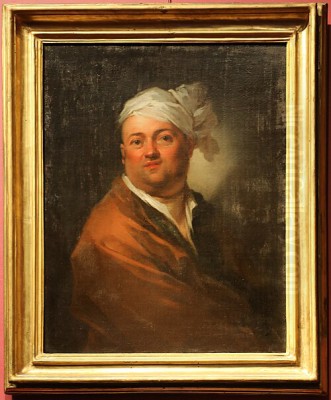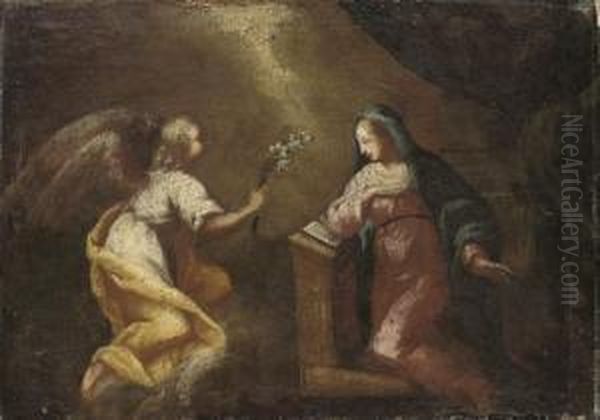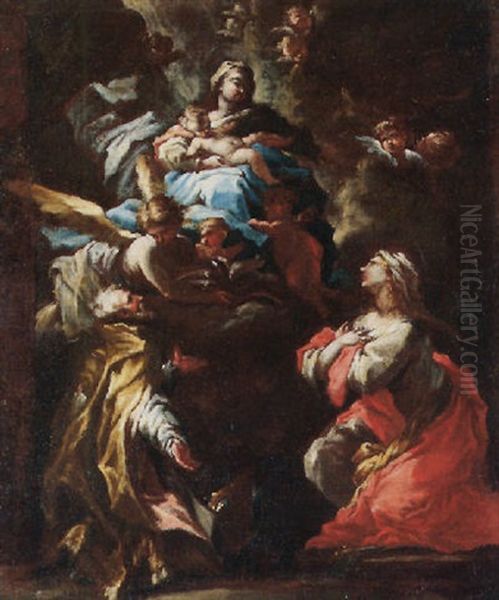
Giovanni Camillo Sagrestani stands as a significant, if sometimes overlooked, figure in the vibrant tapestry of late Baroque painting in Florence. Active during a period of transition and rich artistic cross-currents, Sagrestani carved out a niche for himself, primarily through his religious compositions that adorned numerous churches and private collections. His life and work offer a fascinating window into the artistic, cultural, and religious environment of Florence as it moved from the 17th into the 18th century.
Early Life and Artistic Formation in Florence
Born in Florence in 1660, Giovanni Camillo Sagrestani emerged into an artistic world still echoing with the grandeur of the High Renaissance but fully immersed in the dynamic energies of the Baroque. The city, while perhaps past its absolute zenith of artistic innovation compared to Rome or Venice, remained a crucial center for art production, patronage, and training. It was within this environment that Sagrestani received his initial artistic education.
His formative years were spent under the tutelage of several masters. Among his earliest teachers were Giovanni Giusti, a painter whose local reputation provided Sagrestani with foundational skills. Another significant early influence was Romolo Panfi (also known as Romolo Panfi), who would have further instilled in the young artist the prevailing tastes and techniques of the Florentine school. These initial apprenticeships were crucial in shaping his technical proficiency and understanding of composition and color.
However, a more defining influence on Sagrestani's mature style came from the Bolognese painter Carlo Cignani (1628–1719). While it's not entirely clear if Sagrestani formally studied directly under Cignani for an extended period, Cignani's elegant, classical-infused Baroque style, characterized by its soft modeling, sweet expressions, and harmonious color palettes, left an indelible mark. Sagrestani is often described as a follower of Cignani, yet he did not merely imitate; instead, he absorbed these influences and integrated them into a personal idiom that, while rooted in Cignani's example, developed its own distinct characteristics. This ability to synthesize rather than simply copy would become a hallmark of his career.
The Florentine Artistic Milieu in the Late Baroque

To fully appreciate Sagrestani's contribution, it's essential to understand the artistic climate of Florence during his lifetime. The Medici dynasty, though in its twilight years, continued to be significant patrons of the arts. Grand Duke Cosimo III de' Medici, who reigned for much of Sagrestani's active period, was a notable patron, and Sagrestani himself is recorded as having received his support. The Church, too, remained a primary commissioner of art, with new constructions and renovations of existing chapels and altars requiring a steady stream of paintings and frescoes.
Florentine art of this era was characterized by a blend of local traditions and external influences. While the city's strong legacy of disegno (drawing and design) persisted, there was also an increasing openness to the more painterly and color-driven approaches of Venetian artists, and the dramatic intensity of Roman Baroque. Painters like Luca Giordano (1634–1705), though Neapolitan, spent significant time working in Florence, leaving a powerful impact with his energetic and luminous frescoes, such as those in the Palazzo Medici Riccardi. Sebastiano Ricci (1659–1734), a Venetian, also worked in Florence and brought with him the vibrant colorism of his native city.
Other notable Florentine contemporaries or near-contemporaries whose work formed the backdrop to Sagrestani's career include Alessandro Gherardini (1655–1726), known for his large-scale decorative schemes, and Anton Domenico Gabbiani (1652–1726), a highly respected painter and portraitist who also worked extensively for the Medici. Francesco Conti (1681–1760), slightly younger, would continue the Florentine tradition into the mid-18th century. These artists, along with Sagrestani, contributed to a rich, if sometimes stylistically diverse, artistic scene.
Artistic Style and Thematic Concerns
Giovanni Camillo Sagrestani's art is firmly rooted in the Baroque style, yet it often displays a tenderness and grace that prefigures the Rococo. His primary focus was on religious subjects, a common preoccupation for artists of his time, driven by the demands of ecclesiastical patrons and the prevailing spiritual climate of the Counter-Reformation, whose artistic ideals continued to resonate.
His compositions are typically well-balanced, often employing dynamic diagonal movements and expressive gestures to convey emotion and narrative. He demonstrated a keen understanding of human anatomy and a facility for depicting figures in complex poses. Light plays a crucial role in his work, used not only to model forms and create a sense of volume but also to heighten drama and direct the viewer's eye to the focal points of the narrative. His palette is generally warm and rich, with a preference for harmonious color combinations that contribute to the overall appeal of his paintings.

Sagrestani excelled in depicting scenes from the lives of Christ, the Virgin Mary, and various saints. The Madonna and Child was a recurrent theme, and he often imbued these images with a gentle intimacy and maternal tenderness. His portrayals of saints frequently emphasized their piety, suffering, or moments of divine revelation, rendered with a sensitivity that aimed to inspire devotion in the viewer.
Despite his skills, Sagrestani's style sometimes faced criticism. Some contemporary and later commentators felt his work could occasionally lack profound originality or depth, leading to the spread of what was termed an "ammanatiense" style – a term suggesting a degree of superficial imitation or a reliance on established formulas rather than groundbreaking innovation. This critique, however, should be balanced against his evident technical skill, his ability to create visually appealing and emotionally resonant works, and his consistent productivity which met the demands of his patrons.
Major Commissions and Representative Works
Sagrestani's oeuvre is primarily found within the churches and collections of Florence and the surrounding Tuscan region. His contributions were significant, ranging from large altarpieces to smaller devotional paintings and fresco decorations.
Works in Florentine Churches:
Many Florentine churches bear witness to Sagrestani's activity. For instance, the Church of San Frediano in Cestello (often simply referred to as San Frediano) houses works by him. He also contributed to the decoration of the Church of Ognissanti. Another important location for his work was the Oratory of San Martino dei Buonomini, where he painted scenes from the life of Saint Martin. The Basilica of San Lorenzo, a cornerstone of Florentine religious and artistic history, also featured his art, particularly in the Chapel of the Blessed Sacrament.
One of his notable works is the Ecstasy of Saint Mary Magdalene de' Pazzi for the church of Santa Maria de' Ricci (sometimes referred to as Santa Maria della Fraternità in some contexts, though this can cause confusion with other churches of similar names). This painting showcases his ability to convey intense spiritual emotion through expressive figures and dynamic composition.
Works in Prato and Other Tuscan Locations:
Beyond Florence, Sagrestani's reputation led to commissions in other Tuscan cities. In Prato, he executed significant works for the Duomo (Cathedral of Santo Stefano) and the Church of San Domenico. These commissions underscore his standing as a respected painter beyond the immediate confines of Florence.
The Basilica of Santa Maria delle Grazie in San Giovanni Valdarno is another site where his work can be found, with an altarpiece depicting Saint Ambrose attributed to him. This demonstrates the geographical spread of his patronage.
Specific Masterpieces:
Several specific paintings are frequently cited as representative of Sagrestani's skill:
The Annunciation: A theme he likely painted multiple times, this subject allowed him to explore divine interaction, humility, and grace. His versions typically feature a delicate interplay between the Archangel Gabriel and the Virgin Mary, often bathed in a soft, divine light.
The Martyrdom of Saint Lucy (also known as Saint Lucy before Paschasius): This work, likely one of the four rectangular paintings originally for the Compagnia di Santa Lucia in Cortona, depicts the saint's steadfast faith in the face of persecution. Sagrestani would have focused on the dramatic confrontation and Lucy's serene resolve.
The Flagellation of Saint Euphemia (or Martyrdom of Saint Euphemia): Also part of the Cortona series for the Compagnia di Santa Lucia (later moved to the Chiesa di Santa Maria della Fraternita, also known as the Chiesa della Misericordia, in Cortona), this painting would have showcased Sagrestani's ability to render pathos and physical suffering while maintaining a sense of spiritual triumph. These Cortona paintings are particularly important for understanding his narrative capabilities.
The Holy Family with the Infant Saint John the Baptist: A common and beloved theme, Sagrestani's interpretations would emphasize the tender relationships within the holy group, often set within serene landscapes or intimate interiors. The inclusion of the young John the Baptist adds a layer of foreshadowing and familial connection.
Madonna and Child: Sagrestani produced numerous variations of this central Christian image. These works often highlight his skill in rendering gentle expressions, soft drapery, and a warm, devotional atmosphere. One such Madonna is noted as being in Nancy, France, indicating his work also found its way into collections outside Italy.
Frescoes for the Mannelli Family: Sagrestani was also involved in fresco decoration, a demanding medium requiring speed and confidence. He undertook restoration and repainting of frescoes for the Mannelli family in Florence, demonstrating his versatility. He also copied a painting of Saint Gabriel, showcasing his abilities in replication when required.
These examples illustrate the range of his religious iconography and his consistent ability to deliver works that were both aesthetically pleasing and spiritually engaging, fulfilling the expectations of his patrons.
Influence, Legacy, and His Students
Giovanni Camillo Sagrestani played a role in the continuation of the Florentine painting tradition. He was not only a prolific painter but also a teacher, passing on his knowledge and style to the next generation. His most notable students included Matteo Bonechi (1669–1756) and Giovanni Battista Ranieri del Pace (c. 1681–1740).
Matteo Bonechi became a successful painter in his own right, known for his frescoes and altarpieces, and his style clearly shows the influence of Sagrestani's graceful figures and harmonious compositions. Ranieri del Pace also absorbed his master's teachings, contributing to the decorative arts in Florence. Through these students, Sagrestani's stylistic tendencies were perpetuated, albeit adapted to their own artistic personalities and the evolving tastes of the 18th century.
While Sagrestani may not be counted among the revolutionary innovators who drastically altered the course of art history, his contribution was vital to the artistic life of his time. He provided high-quality, devotional artwork that met the needs of a society where religious imagery was central to public and private life. His consistent output and the dissemination of his style through his pupils ensured his influence was felt within the Florentine school for several decades.
Sagrestani and His Contemporaries: A Comparative Glance
Situating Sagrestani among his peers helps to illuminate his specific artistic position. As mentioned, Carlo Cignani was a paramount influence. Cignani's own work, with its blend of Bolognese classicism and Correggesque softness, provided a model of elegance that Sagrestani adapted.
In Rome, the dominant figure during much of Sagrestani's early and middle career was Carlo Maratta (1625–1713). Maratta's grand, classical Baroque style set the standard for much of Italian painting. While Sagrestani's work is generally less monumental and perhaps more intimate than Maratta's, both operated within a broadly similar artistic language that valued clarity, grace, and decorum.
Giovanni Battista Gaulli, known as Baciccio (1639–1709), was another major figure, particularly renowned for his breathtaking illusionistic ceiling frescoes in Rome, such as the vault of the Gesù. Baciccio's dynamic energy and dramatic use of light represent a more exuberant facet of the Baroque than Sagrestani's typically more restrained approach.
Comparing Sagrestani to Venetian contemporaries like Sebastiano Ricci or Giovanni Antonio Pellegrini (1675–1741) highlights differences in regional emphasis. The Venetians were celebrated for their vibrant color, fluid brushwork, and often more sensuous and lighthearted interpretations, even in religious subjects, prefiguring the Rococo. While Sagrestani's palette was rich, it generally adhered to a more Florentine sense of structure and form.
Among other Italian painters active during parts of Sagrestani's life, one might consider:
Giuseppe Maria Crespi (1665–1747): A Bolognese painter known for his genre scenes and religious works, often characterized by dramatic chiaroscuro and a keen observation of everyday life.
Francesco Solimena (1657–1747): A leading Neapolitan painter whose dynamic and dramatic compositions influenced artists throughout Europe.
Alessandro Magnasco (1667–1749): Known for his highly individualistic style featuring elongated, flickering figures in dramatic, often eerie landscapes or genre scenes.
Donato Creti (1671–1749): Another Bolognese artist, admired for his elegant figures, clear compositions, and often Arcadian or mythological subjects.
The artists mentioned in the initial query, such as Carlo Saraceni (c. 1579–1620) and Bartolomeo Manfredi (c. 1582–c. 1622), belong to an earlier generation of Caravaggisti and represent a different phase of the Baroque, characterized by intense naturalism and dramatic tenebrism. While their influence was foundational for the Baroque, Sagrestani's style evolved from later developments. Giuseppe Angeli (1712–1798) was a younger Venetian painter, more aligned with the Rococo and the circle of Giovanni Battista Piazzetta. Gioacchino Assereto (1600–1649) was a Genoese painter of the early to mid-Baroque. These artists, while important, represent different temporal or stylistic streams than Sagrestani's immediate context, though the broader Baroque era connects them.
Sagrestani's direct artistic lineage and sphere of influence were more closely tied to the Florentine school and the legacy of artists like Cignani. His interactions with patrons like Cardinal Gozzadini and the support from Cosimo III de' Medici further cemented his position within the established artistic structures of his time.
Critical Reception and Historical Reassessment
During his lifetime, Giovanni Camillo Sagrestani enjoyed considerable success. The sheer number of his commissions attests to his popularity and the esteem in_which he was held by patrons. He was a reliable and skilled artist who could deliver works that met the aesthetic and devotional requirements of his clients.
Later art historical assessments have sometimes been more measured. As tastes shifted away from the Baroque towards Neoclassicism and subsequent movements, artists like Sagrestani, who were not seen as radical innovators, occasionally faded from prominent discussion. The criticism regarding a certain "ammanatiense" or formulaic quality in some of his output, as mentioned earlier, also played a role in how his legacy was perceived.
However, modern scholarship has increasingly sought to re-evaluate artists within their specific historical and regional contexts. From this perspective, Sagrestani is recognized as a competent and important contributor to the Florentine Late Baroque. His ability to synthesize influences, his technical proficiency, and the genuine charm and devotional quality of many of his works are now more fully appreciated. His paintings provide valuable insights into the religious sensibilities and artistic preferences of early 18th-century Florence.
The study of regional schools of painting has also brought renewed attention to artists like Sagrestani, who were key figures in their local environments even if their fame did not always achieve the international renown of some of their Roman or Venetian counterparts.
Conclusion: Sagrestani's Enduring Place
Giovanni Camillo Sagrestani passed away in Florence on May 7, 1731, leaving behind a substantial body of work. He was a quintessential artist of his time and place – a Florentine master deeply embedded in the traditions of his city, yet responsive to broader Italian artistic currents, particularly the influential style of Carlo Cignani. His dedication to religious themes, his skillful execution, and his role as a teacher ensured his significance within the late Baroque art scene of Tuscany.
While he may not have been a revolutionary, Sagrestani was a gifted and productive painter whose works adorned numerous sacred and private spaces, contributing to the rich visual culture of his era. His paintings, characterized by their graceful figures, harmonious colors, and sincere devotional feeling, continue to offer aesthetic pleasure and historical insight. As an art historian, it is clear that Giovanni Camillo Sagrestani merits recognition as a distinguished representative of Florentine painting in the transition from the full-bodied Baroque to the more delicate sensibilities that would follow, a testament to the enduring artistic vitality of Florence. His legacy lives on in the churches and museums that house his art, and in the lineage of painters he helped to train.